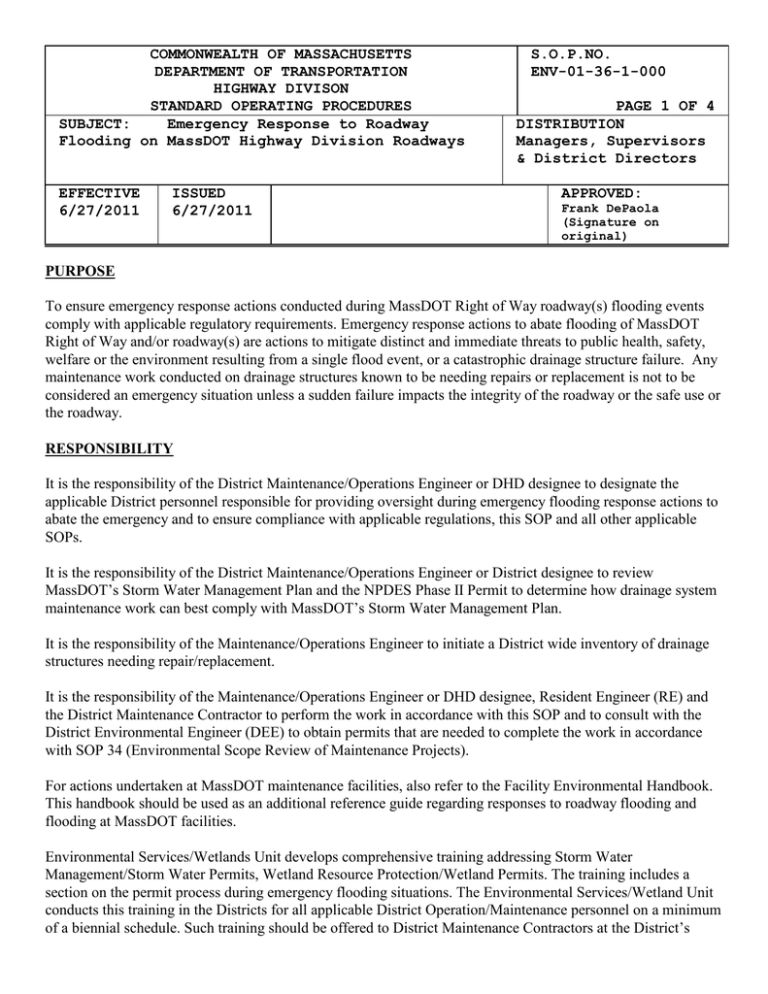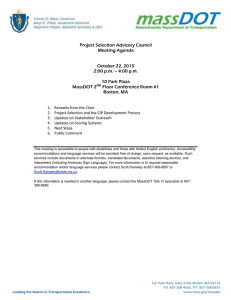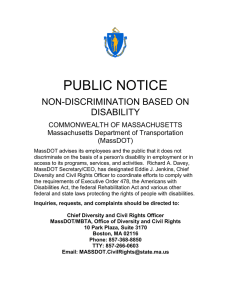COMMONWEALTH OF MASSACHUSETTS S.O.P.NO. DEPARTMENT OF TRANSPORTATION ENV-01-36-1-000
advertisement

COMMONWEALTH OF MASSACHUSETTS DEPARTMENT OF TRANSPORTATION HIGHWAY DIVISON STANDARD OPERATING PROCEDURES SUBJECT: Emergency Response to Roadway Flooding on MassDOT Highway Division Roadways EFFECTIVE 6/27/2011 ISSUED 6/27/2011 S.O.P.NO. ENV-01-36-1-000 PAGE 1 OF 4 DISTRIBUTION Managers, Supervisors & District Directors APPROVED: Frank DePaola (Signature on original) PURPOSE To ensure emergency response actions conducted during MassDOT Right of Way roadway(s) flooding events comply with applicable regulatory requirements. Emergency response actions to abate flooding of MassDOT Right of Way and/or roadway(s) are actions to mitigate distinct and immediate threats to public health, safety, welfare or the environment resulting from a single flood event, or a catastrophic drainage structure failure. Any maintenance work conducted on drainage structures known to be needing repairs or replacement is not to be considered an emergency situation unless a sudden failure impacts the integrity of the roadway or the safe use or the roadway. RESPONSIBILITY It is the responsibility of the District Maintenance/Operations Engineer or DHD designee to designate the applicable District personnel responsible for providing oversight during emergency flooding response actions to abate the emergency and to ensure compliance with applicable regulations, this SOP and all other applicable SOPs. It is the responsibility of the District Maintenance/Operations Engineer or District designee to review MassDOT’s Storm Water Management Plan and the NPDES Phase II Permit to determine how drainage system maintenance work can best comply with MassDOT’s Storm Water Management Plan. It is the responsibility of the Maintenance/Operations Engineer to initiate a District wide inventory of drainage structures needing repair/replacement. It is the responsibility of the Maintenance/Operations Engineer or DHD designee, Resident Engineer (RE) and the District Maintenance Contractor to perform the work in accordance with this SOP and to consult with the District Environmental Engineer (DEE) to obtain permits that are needed to complete the work in accordance with SOP 34 (Environmental Scope Review of Maintenance Projects). For actions undertaken at MassDOT maintenance facilities, also refer to the Facility Environmental Handbook. This handbook should be used as an additional reference guide regarding responses to roadway flooding and flooding at MassDOT facilities. Environmental Services/Wetlands Unit develops comprehensive training addressing Storm Water Management/Storm Water Permits, Wetland Resource Protection/Wetland Permits. The training includes a section on the permit process during emergency flooding situations. The Environmental Services/Wetland Unit conducts this training in the Districts for all applicable District Operation/Maintenance personnel on a minimum of a biennial schedule. Such training should be offered to District Maintenance Contractors at the District’s COMMONWEALTH OF MASSACHUSETTS DEPARTMENT OF TRANSPORTATION HIGHWAY DIVISON STANDARD OPERATING PROCEDURES SUBJECT: Emergency Response to Roadway Flooding on MassDOT Highway Division Roadways EFFECTIVE 6/27/2011 S.O.P.NO. ENV-01-36-1-000 PAGE 2 OF 4 DISTRIBUTION Managers, Supervisors & District Directors ISSUED 6/27/2011 APPROVED: Frank DePaola (Signature on original) discretion. District personnel should refer to MassDOT’s (as MassHighway) “MassHighway Storm Water Handbook” that provides guidance on storm water management. This document should be referenced for all work to identify applicable permit triggers and required authorizations. It is the responsibility of the District Maintenance Engineer and the District Environmental Engineer to be familiar with the “MassHighway Storm Water Handbook”, and all designated District personnel are required to attend any associated training. POLICY MassDOT has developed a National Pollutant Discharge Elimination System (NPDES) Storm Water Management Plan that includes provisions for the inspection and maintenance of the storm water system. Discharges from the storm water drainage system servicing the roadways of MassDOT is authorized under NPDES Phase II Permit (MS4), (permit number MAR043025). The permit is implemented by the MassDOT Highway Division Environmental Services. The cause of the flooding should be identified and documented. Whenever feasible, the flooding should be mitigated using standard MassDOT protocol (e.g. catchbasin cleanout, culvert cleanout, etc.). If the flooding is caused by a catastrophic drainage structure failure, District personnel and/or Maintenance Contractors shall perform emergency repair activities in accordance with the applicable contract requirements and design specifications for the specific drainage structures and any applicable Best Management Practice (BMP). If the flooding is caused by a beaver dam also refer to SOP 33, Beaver Dam Control. In all cases of emergency response to flooding, MassDOT must obtain the necessary permits from any applicable authority including Federal, State or Local (Local authorities include, but are not limited to, Conservation Commissions, Boards of Health, or other public safety officials). Only work deemed necessary to maintain roadway integrity or safe use of the roadway may be conducted while the emergency permit process is ongoing. That work may proceed only to the extent necessary to alleviate the immediate threat to the roadway. Notification to the DEE and the applicable Federal, State or Local authorities must be made as soon as possible after the emergency has been identified. If the cause of the flooding emanates from an abutting or adjacent property, MassDOT must also obtain written or verbal access permission from property owner in order for MassDOT personnel to mitigate the flooding cause. MassDOT may also request that the property owner mitigate the cause of flooding in a timely manner. MassDOT personnel are not to take action on abutter’s property without prior authorization by the property COMMONWEALTH OF MASSACHUSETTS DEPARTMENT OF TRANSPORTATION HIGHWAY DIVISON STANDARD OPERATING PROCEDURES SUBJECT: Emergency Response to Roadway Flooding on MassDOT Highway Division Roadways EFFECTIVE 6/27/2011 ISSUED 6/27/2011 S.O.P.NO. ENV-01-36-1-000 PAGE 3 OF 4 DISTRIBUTION Managers, Supervisors & District Directors APPROVED: Frank DePaola (Signature on original) owner and applicable Federal, State or Local authorities unless a distinct and immediate threat to public health, safety, welfare or the environment exists. Unless a distinct and immediate threat to public health, safety, welfare or the environment exists, MassDOT personnel are not to take unilateral flooding abatement measures or drainage structure repair without consultation with their immediate supervisors and as necessary, the applicable Federal, State and or Local authorities. MassDOT personnel must abide by any and all emergency permit conditions issued by the applicable authorities. Any conditions that, in MassDOT’s opinion, will be detrimental to roadway operations, have an adverse impact on abutters, or would result in a distinct and immediate threat to public health, safety, welfare, or the environment must be discussed by both parties and resolved to the satisfaction of both parties before MassDOT personnel take any action. If necessary, the District should consult with Environmental Services for further guidance in the implementation of this SOP and compliance with applicable regulations. An Emergency Authorization or permit waiver may need to be obtained from the Local Conservation Commissions and Boards of Health to perform work under emergency conditions. The District Maintenance/Operations Engineer must coordinate with District Environmental Engineer/Environmental Services to determine and fully document whether an Emergency Authorization or other waivers are required from Federal, State and/or Local authorities. An Environmental Scope Review (SOP 34) has been developed to facilitate this process. MassDOT field and Contractor personnel must abide by any and all emergency permit conditions. MassDOT personnel are not to take any actions which may violate permit conditions without proper authorization by their supervisors. Any alteration of permit conditions (including verbal authorizations) approved by the applicable authorities must be documented (phone log, email, hard copies) by all parties. Verbal emergency permits from jurisdictional Federal, State or Local authorities for conducting emergency repairs to drainage structures must be followed with written documentation. Should the response to roadway flooding require work in or adjacent to surface water bodies, authorization from the U.S. Army Corps of Engineers (US ACOE) may be required. Provided that it is determined and documented that the flooding presents a distinct and immediate threat to public health, safety, welfare, property or the environment, a waiver of a full US ACOE permit may be authorized to perform the emergency work. Discharge of Flood Waters Should mitigation of the flooded area require pumping or other removal of standing storm water, the recovered COMMONWEALTH OF MASSACHUSETTS DEPARTMENT OF TRANSPORTATION HIGHWAY DIVISON STANDARD OPERATING PROCEDURES SUBJECT: Emergency Response to Roadway Flooding on MassDOT Highway Division Roadways EFFECTIVE 6/27/2011 ISSUED 6/27/2011 S.O.P.NO. ENV-01-36-1-000 PAGE 4 OF 4 DISTRIBUTION Managers, Supervisors & District Directors APPROVED: Frank DePaola (Signature on original) water should first be pumped to downgradient inlets to the MS4 system, if possible. Discharge of storm water in this manner does not require additional permitting or authorization. Discharge of storm water to any inlet of the MassDOT owned MS4 is allowed and permitted under the NPDES Phase II MS4 permit. If the flood water cannot be pumped to available downgradient inlets to the MS4, pumping should be directed to the nearest BMP drainage structure that receives storm water discharges (e.g., detention basin, constructed wetlands, water quality swale, infiltration basin, etc.) or to a constructed temporary BMP. Discharge of storm water to these structures is in compliance with the NPDES MS4 permit and does not require additional authorization. If the pumped water cannot be conveyed to an available Best Management Practices structure, or said structure does not exist, discharge of recovered storm water that is flooding a MassDOT owned location may require direct discharge to a surface water body. Direct discharge of storm water will require permitted authorization from applicable authorities. If direct discharge is required, the discharge should be conducted to a downgradient surface, where possible, and not to surface water, wetland or other regulated surface water (pond, wetland, stream, river, lake, etc.) identified as “Waters of the Commonwealth” as defined under 310 CMR 9.00. Direct discharge of recovered water to non-regulated areas (the ground surface) will not require authorization but may require an access agreement where discharge occurs on land that is not within the MassDOT right-of-way. Where the direct discharge of recovered water to waters of the Commonwealth is required to mitigate a threat to public health, safety, welfare or the environment, discharge to the surface water may be conducted with the advanced written permission of the Local enforcement agency (e.g. Massachusetts Department of Environmental Protection, Local Conservation Commission, Local Board of Health, etc.). When direct discharge to the waters of the Commonwealth is conducted, feasible pre-treatment and flow dissipation measures should be implemented to minimize the release of contaminants to the environment and to mitigate the potential for erosion. The District should consult the Environmental Services/Wetland Unit for further guidance in the implementation of this SOP and compliance with applicable regulations.

